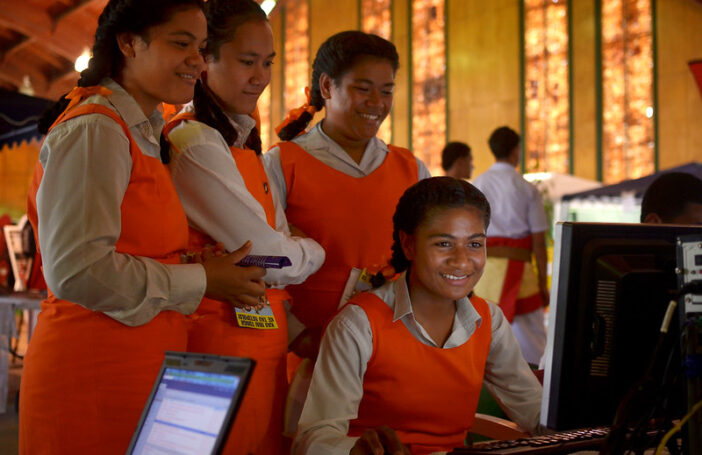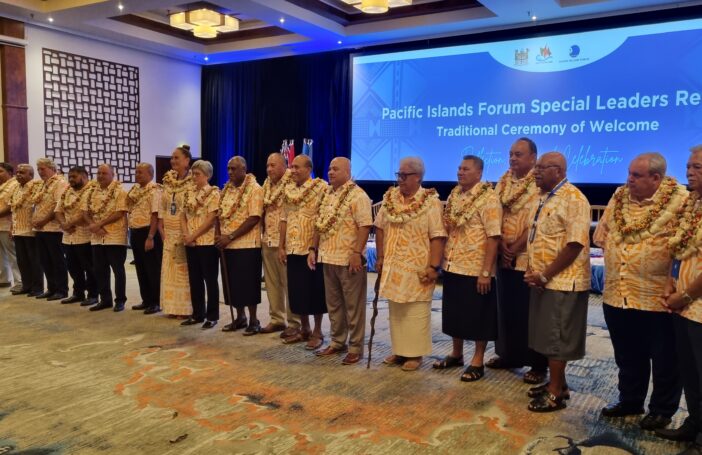500 posts
Last week saw our 500th Devpolicy post. Our readership is also growing by the month – thank you. (On which note, don’t forget our inaugural Harold Mitchell Devpolicy Lecture with Timor-Leste Finance Minister Emilia Pires on Nov. 22 – details here.)
Melanesia (booming) v Polynesia (not)
To the extent that the Pacific has had a success story, Polynesia has been it. Peaceful. If not prosperous, then at least doing well in terms of social indicators. If not always democratic, at least stable. Melanesia has been the opposite: poor, unstable, and with lousy social indicators. But look at the set of Pacific Update posts we’ve recently featured and you’ll come away with a very different impression. The challenge for Tonga, according to its Central Bank Governor Siosi Mafi, is to avert a bleak economic outlook. Exports, remittances, tourism numbers and credit growth are all falling. Public debt and bad private debt are rising. In a similar vein, eminent commentator Kolone Vaai writes of Samoa’s slow economic recovery, its high fiscal deficit, and its falling number of tourists.
By contrast, the updates for Vanuatu and Solomon Islands are very positive. Vanuatu Reserve Bank Governor Odo Tevi writes that Vanuatu has experienced positive economic growth for each of the last nine years. Though the economy has slowed over the last couple of years, it is now accelerating again. Finance Minister Rick Hou explains why economic growth in the Solomon Islands has been over 8 percent for the last few years.
Of course, the contrast is not that straightforward. In the Solomon Islands in particular, there are questions about sustainability. Though growth in PNG is also high, Fiji, the fourth of the Melanesian countries, is stagnating, as Biman Prasad explains in his update. And in all of the Melanesian countries there are challenges in translating growth into improved living standards.
And yet, the change in fortunes between these two Pacific regions is too important and striking to go unremarked. The most important reason is the worldwide resource boom which the larger, resource-richer Melanesian countries are in a better position to take advantage of. But it’s not only resources. The total number of visitors (by air and ship) to Vanuatu has more than doubled over the last decade. A more competitive and prosperous Melanesia is good news for the Pacific.
We’re now planning for our 2013 Pacific Update, which will be held in Canberra in July. More details to follow soon.
Aid and the Pacific Solution II
Joel Negin does us all a favour with his careful dissection of the aid issues around the revamped Pacific Solution. He clarifies a few basic points: aid isn’t and won’t be used for processing centres, but aid is and will be used for broader but related investments (power and water) and as implicit payments to government for services rendered. He also highlights the risk that aid might get diverted to pay for on-shore processing costs. Australia has not claimed more than a little ODA credit for this in the past, but other countries have, to the tune of hundreds of millions. With fiscal stress on the increase, and the Government promising to increase aid by $600 million in the next budget, this is something to watch for.
Tripling climate finance at Doha
Each annual UN climate change conference seems to promise less and matter less than the one before. Perhaps that is a good thing, as countries get on with the business of actually reducing emissions. But there is at least one immediate matter for the December 2012 climate conference at Doha to attend to (alongside the longer-term goal of starting to negotiate a 2020 treaty, on which few expect any breakthroughs). One of the most far-reaching of the decisions made at the infamous 2009 Copenhagen conference was the commitment by developed countries to provide $100 billion in climate financing by 2020, starting with $10 billion for each of 2010, 2011, 2012. That “fast start” period is now up. How much will developed countries offer up for the next three years? Jonathan Pickering argues that they should maintain aid funding (the dominant funding source to date) of climate financing at current levels, and introduce at least as much funding from private or “innovative” sources, such as new global taxes or levies. Overall, he argues, the aggregate amount of finance on offer should triple over the next three years, from $10 to $30 million. That’s a huge ask, which means that the stakes to play for at Doha are much higher than has been recognized to date.
More on Pacific seasonal workers.
Some people have questioned what I am trying to achieve by running “negative” interviews with industry players on the Pacific seasonal worker scheme. As a supporter of greater labour mobility for the Pacific, the low take-up of the Australian Pacific Seasonal Worker Pilot Scheme has been a major disappointment. At the Seasonal Worker conference in August of this year, I was struck by the extent to which industry views for the slow take-up coincided with the research Danielle Hay and I did in 2011. I’m very grateful to Anna Berry and Rob Hayes for their willingness to go on the record with their views. The interview with Rob Hayes provides strong support to the view that, as Danielle and I argued, giving backpackers a second year’s visa if they work on farms in their first year has done away with the horticultural labour shortage. And if you have ever wondered how pervasive the use of illegal labour is in horticulture, read the interview with Anna Berry.
It would be good to have something more positive to say about the Pacific Seasonal Worker Program (the permanent replacement for the Pilot). One thing we certainly noticed in our research was that those who had used the scheme were positive about it. We haven’t done any systematic research into productivity gains from using seasonal workers, but I understand (from our own Making Migration Work conference in April 2012) that there are some positive productivity results in the Government’s own evaluation of the pilot scheme. This is one reason it is so disappointing that the Government has delayed the release of this evaluation so long, a point I make in this post.
To end on a positive note, it is to the Government’s credit that it has now extended the scheme to the sugar cane, cotton, aquaculture and seasonal tourism. Let’s hope one of these takes off. I’m delighted that next year Danielle Hay will be returning to Devpolicy to undertake more research on the Seasonal Worker Program and more generally on Pacific labour mobility.
October posts
You can find a summary of all October posts in the list below. Don’t forget our expanded set of buzzes. We provide monthly wraps on Australian aid, global development, education and development, and aid & Asia, as well as the fortnightly Pacific buzz (here, here and here).
Aid
Aid and the Pacific Solution II: issues and questions by Joel Negin.
Given financial pressures, there is surely a risk that increasing amounts of aid will be tied to the Pacific Solution, or even to onshore processing.
AusAID’s country strategies: why such a modest improvement since 2009? By Stephen Howes and Jonathan Pryke.
[T]he limited improvement in the completion rate is surprising.
Supporting good practice in monitoring and evaluation in partner countries – lessons from Uganda by Christine van Hooft.
A recent assessment … indicates that at least twelve central government agencies [in Uganda] have some role in conducting monitoring of public service provision.
NGO dependency not the real issue: a response to Joanne Spratt by Patrick Kilby.
Despite [the] almost overwhelming evidence, questions still keep being asked if NGOs are effective and deliver ‘value for money’.
To strive or to serve: how should NGOs promote sustainable development? By Terence Wood.
… NGOs could make some of their most difficult choices easier in the long run: coupling their current work with research and rigorous impact evaluations.
Note: AusAID Discussion Paper on Impact Evaluation by Robert Cannon.
This Discussion Paper is excellent. It is sensible, well-grounded in current good practice, succinct, helpfully referenced and practical.
Should we give aid to countries with questionable human rights records? By Dinuk Jayasuriya.
The question should not be “Should we give aid to countries with questionable human rights records?” but “How can we effectively reach the most vulnerable people in countries, especially those who face human rights violations, all while not inadvertently supporting the regime in power.”
Development Policy
The MDGs post-2015: why we should do less by Bill Morton.
[N]ow is the right time for practitioners and analysts in developed countries to take a step back, and to make room for people in developing countries to advance their own thinking on a post-2015 framework.
Caution! Using high stakes testing of student learning in development by Robert Cannon.
With our current state of knowledge, it is dangerous to think that the use of these high stakes tests can have a constructive role in the development of education.
Increasing climate financing: the challenge for Doha by Jonathan Pickering.
Wealthy countries could commit to at least maintaining or moderately increasing existing levels of public climate finance from national budgets over the period 2013-15 (say at around $10-15 billion a year), coupled with an equivalent or larger increase in finance from innovative public and private sources.
How do I get started in a career in development? By Jonathan Pryke.
Based on my own experience and drawing on extensive consultation, the paper aims to start a conversation about what a career in development actually is, what you can do to better your chances of getting started and where you can look.
The Pacific
Slow economic recovery, disappearing tourists: a Samoa update By Kolone Vaai.
In terms of challenges, I think it’s really in the external sector. Until we can turn round tourism, we are going to remain vulnerable.
Tonga: averting a bleak economic future? By Siosi C. Mafi.
On balance, recent economic developments in Tonga have been negative and our economy is in need of a lot of support. We need to get out of relying so heavily on private remittances and become more productive.
Illegal labour and red tape: another industry perspective on the Pacific Seasonal Worker Program An interview with Anna Berry.
If illegal labour goes, I think that’s the farmers will say yes to seasonal workers, because then they’ll have no choice, except to pay the price that the seasonal workers are asking.
Why there isn’t a labour shortage in horticulture: an industry perspective on backpackers and the Pacific Seasonal Worker Program An interview with Rob Hayes.
[T]here isn’t a labour shortage per se. I could pretty much guarantee that we could find workers for anyone who is looking for them.
Vanuatu resurgent by Odo Tevi.
Despite its openness and smallness, Vanuatu’s economy has been performing well over a number of years. It had weathered the global financial crisis and the political instabilities that the various governments have gone through.
Palm tree justice: inside the Regional Assistance Mission to the Solomon Islands by Tess Newton Cain.
Drumgold’s account raises more questions than it answers and is open to challenge on numerous fronts, but it is a compelling read for anyone who cares about law, justice, Pacific development and the points where these converge and/or clash.
Managing the political economy of development in Solomon Islands by Rick Hou.
Political interference can lead to poor outcomes and lost opportunities at both a community and economy-wide level. This challenge is often raised with respect to state-owned enterprises, but it is even more applicable in the wider public service, and is a particular issue in the appointment of departmental CEOs.
We want what the Ok Tedi women have! By Nicholas Menzies and Georgia Harley.
In securing control of 10%, the women at Ok Tedi did something women hadn’t done anywhere else in the country – and as far as we can discern, anywhere in the world.
Social challenges in PNG by Serena Sasingian.
At The Voice Inc., we believe young people are leaders in creating the future today. Young people lead by example, they lead by their gifts, talents and skills, we must give them every opportunity they need to lead today.
Stephen Howes is Director of the Development Policy Centre.





